Ants are quick-witted creatures who will find their way into your house quickly. Bathrooms are especially vulnerable to an ant infestation because most ants require a warm, humid, and moisture-filled atmosphere to thrive. It is in bathrooms that ants build entire colonies. This behavior can prove to be a big nuisance for you because once the ants settle in, it is hard to drive them out. You will end up shelling a lot of money to get rid of an ant colony if you are not careful.
This guide will help you identify the early signs of an ant infestation and steps as to how to eliminate them.
Types of Ants That Like Your Bathroom Sink
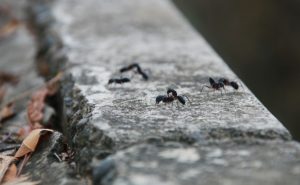
Ants are a diverse species. The first step to removing the ants from your bathroom is to figure out which species you are dealing with. Some of the common ant species found in bathrooms are as follows.
Moisture ants
These ants are long and look yellowish-brown. This is why they are sometimes called ‘yellow ants.’ They are 4 to 4.5 mm in size. They are confused with Carpenter ants due to making nests in damp environments, such as a bathroom. As their name suggests, Moisture ant nests are common in areas with moisture. A bathroom is a place with a lot of dampness and humidity, so make sure you get rid of them as soon as you spot the first few.
Carpenter ants
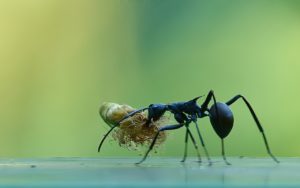
These ants are ‘carpenters’ because they carve out, chew, and make their nests in wooden objects. They are red or black or a mix of both. They are often confused with Moisture ants but are slightly bigger than them. Carpenter ants can range from 0.5 mm to 8 mm long. Carpenter ants do not eat the wood surface but just chew through them to make a colony. If you spot any extra moisture or soft spots on a rotten wooden surface, then it is likely an infestation. In the case of a bathroom, you can spot them between walls, the flooring, and even the bathroom corners.
Argentine ants
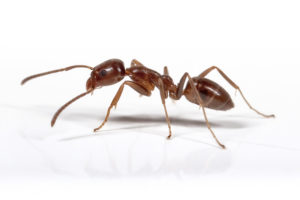
Argentine ants come from Argentina, and they are now everywhere across the globe. These ants are dark brown or shiny black, and their size can go up to a quarter inch. These ants love moisture and sugary food. You will find Argentine ants around the toilet or under the toilet seat. If you spot a long ant trail leading up to a crevice in your bathroom, it may be an Argentine ant infestation.
Ghost ants
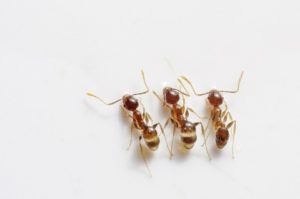
Ghost ants are ‘ghosts’ because they are difficult to spot. This difficulty comes from their pale yellowish color, which sometimes looks white. These ants can grow up to 1.5 mm long. Ghost ants also love sweet food. These creatures need a lot of moisture to survive, so you will find them close to water sources. They tend to lurk near sinks, showers, tubs, etc.
Look for The Trail or Their Colony
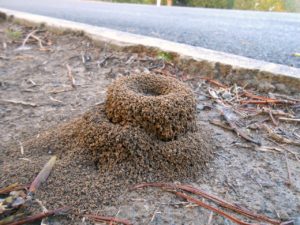
Locating the ant’s trail or colony will help you find out their entry and exit areas. Usually, ants come from a hole or a vacuum in the house that leads outside. You will find them in corners or holes between your tiles, flooring, dividers, etc. Observe the movement of the ants and the direction they are walking to and from. Looking for their trail or colony will take you to the source of the problem, and you can tackle it better.
Ways To Get Rid of Ants in Bathroom Sink Once And For All
Clean out your sink drain
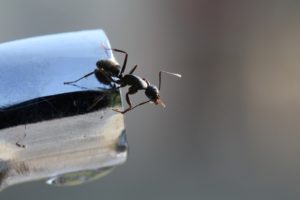
Sink drains are a hotspot for ants because they have a lot of food for ants. In addition, sinks often have debris, decaying hair, or food particles, and ants love those. To prevent ants from crawling out of your sink or drain, you must regularly clean the debris. Use vinegar and baking soda to acidify the trash and clean the sink. You can also use a drain cover to stop the waste from entering the plumbing.
Seal cracks
Ants can use any crack, corner, or crevice to crawl into the space. Bathrooms see a lot of wear and tear as they are used almost every day, sometimes multiple times. As a result of use, you might start seeing cracks in the sealing of your tiles or flooring. Sometimes, even your walls might begin to crack, and ants will use that as an opening.
It is vital to seal any cracks on the walls or the floor as soon as possible.
Replace broken tiles
Just like seal cracks, even broken tiles act as passageways for ants. Ants will create a nest inside the tile debris, and then it will be difficult for you to remove them. To avoid this, it is best to replace your tiles as soon as they break or get chipped.
Use of Insecticides
Insecticides are effective to a large extent. They are reliable as they kill the root cause of the problem. There are many insecticides specifically built for ants that you can use to solve your ant problem. Remember that insecticides are also toxic to us humans. Always use gloves when spraying these on the affected areas and avoid your skin from contacting these toxic substances.
Trap the ants
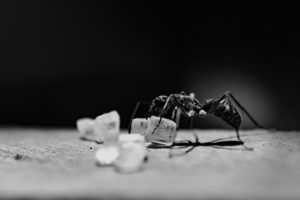
You can use ant traps to catch the ants in your bathroom. Some simple ways to trap ants are to use bait stations and gels. Baits such as Raid Max, Syngenta Bait Gels, etc., are pre-filled traps that attract ants so that the ants will eat them or take them with them to their colony. Once the ants open it, the toxic liquid will kill the ants. Another method to trap ants is to use gels. Insect gels or even gels we use in daily life can help you say goodbye to the ants. Apply these gels to the ant entry points, soon die.
Dehumidification
Dehumidification means doing away with the humidity or the air moisture in a closed space. Ants love burrowing into cold, damp corners. Dehumidifying ensures that there are no damp corners in the bathroom. You can use an external dehumidifier to get rid of the moisture. Dehumidifying also means letting in a lot of air into your bathroom so that the ants never find a good enough spot to call it home. You can dehumidify the bathroom without using a dehumidifying appliance is to clean the bathroom after using it, using a floor mop to dry the tiles, and not leaving water in tubs or buckets. If you have any drippy plumbing, fix it immediately so that your bathroom is not damp at all times.
Contact an exterminator
If you have tried and tested all the steps above and the ants still do not leave your bathroom alone, you must accept that this is a job for the experts. Calling an exterminator to get rid of the ants for you is a safe and reliable alternative. Exterminators are experts who will identify the kind of ant infestation and threat level and act accordingly. Remember to call in a professional who has experience because a job half-done will not change anything for the ants.
DIY Remedies
Create your ant repellent
Even though many pesticides and chemicals are readily available in the market, you can customize yours to kill off ants in the bathroom. Creating your own ant repellent is easy. You can use different scents in it, to drive the ants away. Using essential oils such as tea tree oil, eucalyptus or peppermint oil will kill off the ants. Use these oils and add some pepper and cinnamon, a little water and spray it all around the bathroom. You may also pour some of this mixture into your drain to clean it out.
Use vinegar and baking soda
Using vinegar and baking soda paste is a good solution to prevent the ants from coming up the sink or the drain. White vinegar works the best. To create an effective cleaning agent, follow these steps.
- Pour half a cup of baking soda and half a cup of vinegar in your sink.
- Let the mixture run through the drain for at least 30 minutes.
- Pour lukewarm to warm water in the drain.
This combination will help in unplugging your drain and washing the ants off.
Chalk or baby powder
Using chalk or baby powder is a quick and easy fix to keep ants at bay. Sprinkle some baby powder or draw a chalk line at the ants’ entry point – in front of the ant hole or their nest. Ants do not cross the marked line for an unknown reason. Researchers think that chalk’s scent keeps them away. This is an inexpensive method but quite temporary. Once the line is blurred or the powder is gone, the ants will start again. We recommend using this as a quick fix rather than a long-time solution.
Boric acid
Boric acid is a harmful powder for insects, pets, and even adults. If you are using boric acid to keep the ants at bay, avoid direct skin contact with it. Please do not use it in the reach of animals or children. To make the application safer, you can add some water and sugar to it (to attract ants) and spray it along the edge of the ant trail.
Cucumber or citrus peels
Cucumber and citrus scents are repellent for ants. To keep ants away from your bathroom, you can place citrus or cucumber peels in the ant-infested areas. If you do not want food in the bathroom, a better solution is to buy a cleaning agent with citrus in it.
What Attracts Ants In The Bathroom?
There can be many attractive factors in the bathroom that may draw ants in. Some of these might be continued dampness in the bathroom, clogged drains, or leakages. Ants are attracted to plumbing due to the scents and water. Bathroom spaces are a perfect breeding ground for ants due to the sweet smells, moisture, and harsh environmental factors. Ants can feed on debris in the bathroom, such as hair, urine, or food.
FAQs
Ants love moisture and damp, dark places to settle in. A bathroom is a perfect spot for ants to inhabit as they are left alone and can form colonies in the bathroom. The smell of soaps, body salts, perfumes, lotions, scented candles, etc., can tempt the ants to make a home in the bathroom.
Yes, using insecticides will get rid of the ants in your bathroom. It is quick and inexpensive. But, using insecticides is toxic to you and the environment. Spraying insecticides in an area where you clean, such as the bathroom, is a sure way of inhaling toxic fumes and scents from the chemical. Using natural remedies is a much better and safer option.
Wrapping Up
We hope that this guide helped you identify and tackle the ant infestation in your bathroom. Remember that ants are quite the workers, and they will creep back into your house with a bit of leeway. They can also make a permanent home in other house areas, such as your kitchen or storage areas. They love places that are easy to get to and dark. To prevent ants in your space, keep performing thorough checks in incredibly dark, moist corners of your house. For your bathroom, get a dehumidifier or improve ventilation to let in some sun and air. To kill off any ants or deter them from coming back, use a non-toxic chemical solution, or make one, as mentioned above.
If you feel like your problem is too big to solve, consult a professional exterminator to get rid of the ants once and for all.